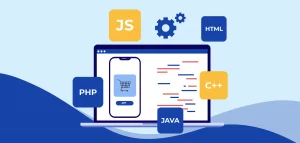Table of content
To begin with, Front end Frameworks are tools or platforms that assist developers in building the front end of websites or applications. The front end of a website or application includes everything visible to the user, such as graphics, typography, and the layout of the website. In addition, it involves creating user-friendly interfaces and efficiently presenting data from the back end to the user.
A Front end Framework is used to perform various tasks such as managing AJAX requests, associating data with the Document Object Model (DOM) elements, defining a file structure, and styling components on the website or application. When it comes to the best front end Frameworks for web development, there are many options available, and developers may have debates about which one is the best. However, based on recent studies and surveys, we have compiled a list of the best front end frameworks for you, according to the number of Github stars they have received.
React
React, also known as ReactJS, is a widely used front end JavaScript library that enables developers to create user interfaces and other related components. It is designed with the Model-View-Controller (MVC) architecture, with a separate layer for presentation and data availability. One of its unique features is the Virtual DOM, which efficiently manages document access and manipulation. The Virtual DOM interacts seamlessly with HTML and XML documents, treating them like a tree structure with each HTML element functioning as an object.
React is developed by Facebook and is considered an excellent tool in the front end development toolkit. It employs a coding style called JSX, which combines HTML quotes and tag syntax to create components. React enables developers to break down larger components into smaller ones that can be managed separately and independently, enhancing productivity.
Some advantages of using React include the ability to reuse components for collaboration and in other parts of the application. Virtual DOM helps to maintain consistent and smooth performance, while React hooks offer an efficient way to write components without classes, making it easier to learn React.
Angular
Angular is a leading front end framework that has become a popular choice among web developers. It is designed to build advanced and efficient single-page applications. Angular is a development platform that uses Typescript and is created by Google. It is a component-based framework that is capable of developing scalable web applications. Angular provides developers with a set of tools that enable them to create, build, test, and modify code. Additionally, Angular features a collection of well-integrated libraries.
Angular’s scalability allows you to create enterprise-level applications based on your specific requirements. Some of the most notable companies that use Angular are YouTube and Google Translate. Angular’s extensive list of features is one of the primary reasons for its popularity.
Angular’s built-in functionality enables the adjustment of the model to the view and vice versa. This feature allows for a decrease in code as it provides essential features such as two-way data binding by default. Components are decoupled from their dependencies, making them more manageable when defined as external elements. Angular’s dependency injection makes components reusable and simple to manage.
Lastly, Angular boasts a large learning and support community, making it easier for developers to get help when needed.
Vue.JS
Vue.js is a modern and progressive framework that is designed using the Model-View-ViewModel (MVVM) architecture. Vue.js is considered as one of the best JavaScript libraries that offers a lightweight and easy-to-use approach to creating interactive user interface elements. It offers a flexible and straightforward API, which provides data-reactive elements, making it easier for developers to develop applications.
Vue.js allows incremental adoption to a greater extent, making it easier to start with smaller projects and then scale up to larger ones. It is a lightweight framework that is easy to install and download. Vue.js can be used to create both small and large-level templates, and it provides a quick way to identify errors, saving time and effort. Vue.js also simplifies the binding of existing applications and offers extensive documentation. Additionally, it can help developers to understand other front end frameworks such as Angular.js and React.js.
The MVVM architecture used in Vue.js simplifies the handling of HTML blocks, making it easier to develop applications. Vue.js has numerous advantages, including its tiny and fast size, which makes it ideal for developing high-performance applications. It is beginner-friendly and has a simple syntax that is easy to learn. Two-way data binding is another advantage that simplifies the development process. Vue.js also has a positive effect on Search Engine Optimization (SEO).
Vue.js has gained widespread adoption across various industries, including Netflix, Facebook, Grammarly, Trivago, GitLab, Xiaomi, Adobe, Alibaba, Reuters, Nintendo, and many others.
jQuery
jQuery is a popular and widely-used front end framework that was created by John Resig. It is a small, fast, and feature-rich library that makes client-side HTML scripting easier. jQuery is one of the oldest front end frameworks that is still popular among developers.
One of the key benefits of jQuery is its cross-platform API that works across a wide range of web browsers. This makes tasks like event handling, Ajax, animation, document traversal, and manipulation much easier. jQuery is extensible and versatile, which has revolutionized the way designers write JavaScript. Due to its versatility and ease of use, jQuery is used by over 41 million websites.
jQuery is highly adaptable when it comes to adding and removing elements from the Document Object Model (DOM). This flexibility is an advantage when working with dynamic content. Additionally, jQuery streamlines the process of sending HTTP requests, making it easier for developers to manage dynamic content.
Overall, jQuery has numerous advantages that make it a popular choice among developers. Its extensibility and versatility make it easy to use for beginners, while experienced developers appreciate its flexibility and ability to streamline HTTP requests. With its widespread adoption, jQuery is one of the oldest and most popular front end frameworks available today.
Ember.JS
Ember is a well-known, open-source front end framework that can help developers create modern user interfaces for web solutions, mobile and desktop apps, and cross-platform applications. It follows the MVVM (Model-View-ViewModel) architectural pattern and is designed to simplify the development of complex, scalable applications.
One of Ember’s significant advantages is its ability to perform server-side rendering, which can boost the performance of the application. This framework also has a robust and consistent documentation process, allowing developers to quickly resolve issues and learn new features.
Ember’s widget-based approach to components makes it simple to create and manage reusable UI components. Additionally, two-way data binding allows for quick and straightforward interaction between the UI and the data layer.
Another advantage of Ember is its URL-focused approach, which enables developers to structure their applications in a logical manner. This results in a more intuitive user experience, as users can understand the hierarchy of the application’s pages.
Ember also has a well-organized community that is continually expanding and improving the framework. It provides excellent support for both JavaScript and TypeScript, a typed superset of JavaScript that can improve code readability, and provide better tooling and error detection. Additionally, Ember generates a testing program by default for each new entity, which is a helpful feature for developers.
Final Word
Since each business has different goals, it is essential for developers to choose the right front end framework for their project. There are several frameworks available, and each one offers a unique set of features. It is important to choose a framework that fits the specific needs of the project, whether it is creating modern user interfaces for web solutions, mobile and desktop apps, or cross-platform applications.
It is worth noting that there is no one-size-fits-all solution when it comes to choosing a front end framework. Developers must evaluate the requirements of the project and decide on the appropriate framework that meets those requirements.







